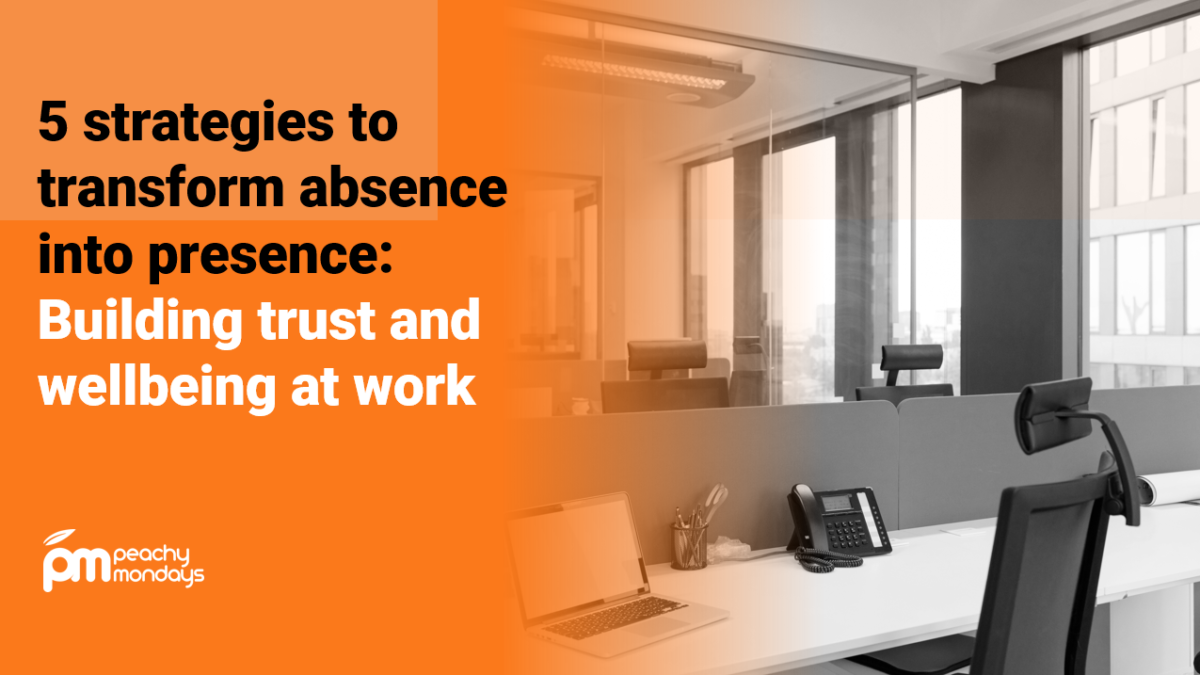5 strategies to transform absence into presence: Building trust and wellbeing at work
Monday 5th February was National Sickie Day – statistically the day that the most people will call in sick to work. Managing absence, wellbeing and work-life balance is becoming an even bigger challenge to organisations and the recent CIPD/SimplyHealth report shared that the UK was experiencing a 10-year high in employee absence. Is this all an indication that colleagues are trying to reset the work-life balance in favour of the ‘life’ part?
A few things come up repeatedly in research on this matter and are highlighted in the CIPD report.
- For the most part, organisations know wellbeing is important and more are adopting a stand-alone strategy for health and wellbeing (i.e. it’s not just part of engagement or policy work)
- The level of support for individuals varies a lot across organisations.
- When organisations focus on evaluating their health and wellbeing efforts, they generally find the outcomes improve – helping to drive a business case for further and future investment.
- Widespread issues of presenteeism (working while unwell) and leaveism (using leave for work) persist, indicating potential gaps in work-life balance.
What can organisations do to address increasing absence rates?
1. Reset the agenda
Being sick does not make us a bad person, working 12-hour days does not make us a good person. Our work is not our worth. Trust, empowerment and autonomy are all critical cultural elements of organisations who manage productivity and wellness in balance.
Think about absence rates not as KPI as a cost to be managed down, whatever the cost, but more as an indication of the overall organisational health. If the levels of absence, sickness, ill health and stress are too high, look at those as symptoms of an unhealthy organisation – and seek to manage the root causes.
Is it workload? Resources? Change? Micro-managing Managers?
2. Increase management capability and focus on ‘energy’
Managers have been trained to focus on inputs (time) and outputs (deliverables) but less so on managing energy levels within a team. Each person has part of a ‘pot’ of energy to spend on their working day. Work shouldn’t be the whole pot. Each person has different ways to refill or maintain their pots, and they will be depleted at different rates by different things. Understanding that can be the key to creating a great work-life balance within a team.
3. Leadership role modelling
Leadership plays a crucial role in modelling a culture of wellbeing within any organisation, highlighting the importance of prioritising mental and physical health. Actively taking holidays and not working while sick, demonstrates a powerful commitment to personal health and work-life balance but also signals to the workforce that their wellbeing is valued.
When leaders visibly take time off for rest and recovery, it legitimises the same behaviour in their teams, encouraging employees to take necessary breaks without fear of repercussion or judgment. This behaviour fosters a healthier work environment, where taking care of one’s health is seen as essential to sustaining high performance and overall job satisfaction. Ultimately, leadership that embodies these values contributes to a more resilient, engaged, and productive organisation.
4. Review processes – STOP rewarding ‘perfect attendance’
If you have any recognition schemes which reward ‘perfect attendance’ – it’s time to retire these. They can inadvertently discriminate against individuals with health issues, disabilities, familial responsibilities, or those facing socioeconomic challenges, as well as encourage an unhealthy degree of presenteeism – which in the end, will just prolong illness.
5. Ramp up your data-driven decision-making with continuous listening
Prevention is better than cure, so how can you use continuous listening to ensure interventions are working, identify early warning signs and dig out those root causes? Continuous listening can help you:
- Understand expectations and realities for new hires
- Explore specific needs and challenges related to health and wellbeing
- Measure the effectiveness of wellbeing support initiatives throughout the employee lifecycle
- Identify trends, address concerns, and make data-driven decisions to improve their offerings.
- Proactively monitor stress levels and mental health indicators among employees.
- Identify warning signs through sentiment analysis and open-ended feedback
- Identify root causes of an unhealthy organisation
- Determine the relationship between engagement and working environment with sickness absence rates to identify route causes and take action.
Using continuous listening strategies, organisations can gain valuable insights into their workforce’s wellbeing landscape, tailor their solutions accordingly, and drive positive change.
Conclusion
The challenge of achieving a harmonious work-life balance is big. As the boundary between professional commitments and personal life becomes increasingly blurred (accelerated by hybrid working), it’s evident that organisations need to address the gaps. The rise in absence figures and the continued issues of presenteeism and leaveism serve as wake-up calls, emphasising that we need to look again at our conventional understanding of productivity and commitment. Trust, autonomy, and empathy from the leadership position, combined with equipping managers with the right tools to understand and manage their teams’ energy levels, can pave the way for a healthier work environment.
However, change can’t be mere lip service. Continuous listening, as an approach, provides actionable insights. By continuously monitoring and analysing employee feedback, trends, and health indicators, organisations can stay ahead of potential challenges and create workplaces that value both performance and wellbeing.
Begin by looking inward, evaluating the state of your employees’ wellbeing. Integrate continuous listening into your strategies today, and let’s pave the way for healthier, happier, and more productive workplaces. Your employees’ wellbeing isn’t just a metric; it’s the heartbeat of your organisation. Listen to it.
Related Posts
Categories
- Case Study (13)
- Change and transformation (21)
- Connectedness (4)
- Culture (17)
- Design (10)
- Diversity and Inclusion (1)
- Effectiveness (16)
- Employee engagement (60)
- Employee experience (43)
- Employee Feedback (51)
- Employee Wellbeing (1)
- Events (10)
- Financial Wellbeing (1)
- Happiness (4)
- Internal Communications (10)
- News (24)
- Onboarding (1)
- Organisational Effectiveness (18)
- Uncategorized (3)




